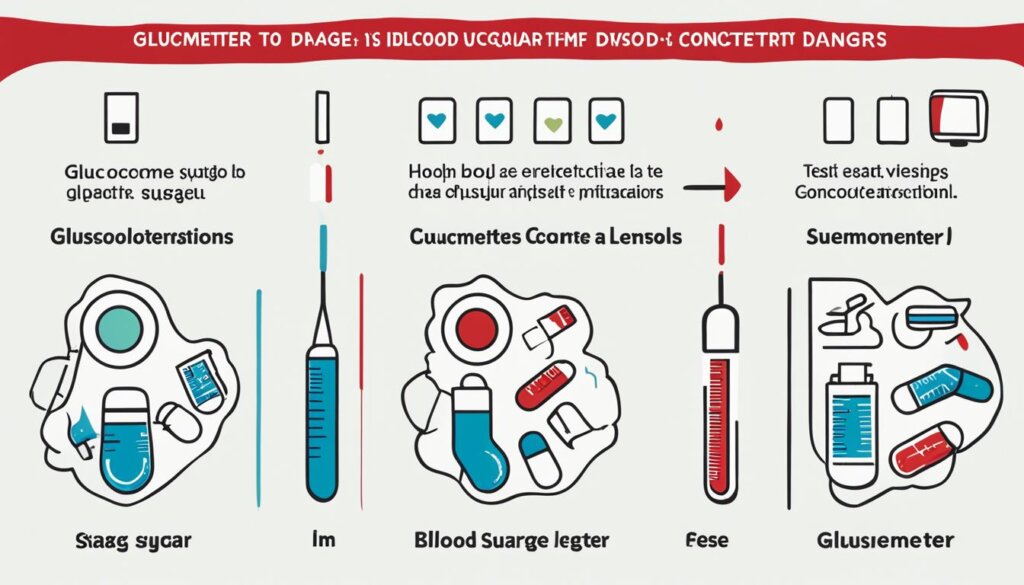FTC disclaimer: This post may contains affiliate links and we will be compensated if you click on a link and make a purchase.
Did you know that a blood sugar level of just 240 mg/dL (13.3 mmol/L) can be dangerous? It can even lead to emergency situations. This fact shows how important it is to know what blood sugar levels are safe. It’s especially true for people with diabetes.
High blood sugar, or hyperglycemia, is a big problem for many with diabetes. It might not show symptoms until levels go above 180-200 mg/dL (10-11.1 mmol/L). But, keeping glucose high for a long time can cause big health problems. These include heart disease, nerve damage, kidney issues, and vision problems.
When blood glucose goes over 600 mg/dL (33.3 mmol/L), it can cause a serious condition called hyperosmolar hyperglycemic state. This needs quick emergency care. Knowing when blood sugar is too high is key to managing diabetes and avoiding big health issues.
Key Takeaways
- Hyperglycemia (high blood sugar) is usually not symptomatic until levels reach above 180-200 mg/dL (10-11.1 mmol/L).
- Blood glucose levels above 240 mg/dL (13.3 mmol/L) are considered dangerous and can lead to emergency situations.
- Extremely high blood sugar over 600 mg/dL (33.3 mmol/L) can trigger life-threatening hyperosmolar hyperglycemic state.
- Untreated hyperglycemia can cause long-term complications like cardiovascular disease, nerve damage, and vision problems.
- Recognizing early symptoms of hyperglycemia is key to prompt treatment and prevention of serious health issues.
Understanding Hyperglycemia: When Blood Sugar Levels Soar
Hyperglycemia, or high blood sugar levels, is a serious issue. It happens when the body can’t handle glucose well. This is often because of insulin resistance or not enough insulin.
Symptoms of Hyperglycemia
Hyperglycemia doesn’t show symptoms until blood sugar is over 180 to 200 mg/dL. Early signs include needing to pee a lot, feeling thirsty, blurry vision, and feeling weak or very tired. If not treated, it can cause toxic acids to build up, leading to bad breath, dry mouth, stomach pain, nausea, vomiting, shortness of breath, and confusion. If you have these symptoms and your blood sugar is over 240 mg/dL, get medical help right away.
Keeping blood sugar in check is key for people with diabetes. High blood sugar can lead to serious problems like diabetic ketoacidosis and diabetic retinopathy. Testing blood sugar often and working with doctors can prevent these issues and keep you healthy.
“Hyperglycemia is a serious condition that can lead to life-threatening complications if left untreated. Recognizing the early warning signs and seeking prompt medical care is crucial for managing this condition effectively.”
Level of Blood Sugar: Hypoglycemia and Its Dangers
Hypoglycemia, or low blood sugar, is a serious issue for people with diabetes. It happens when blood sugar drops below 70 mg/dL. This can cause symptoms and serious problems. Those with type 1 diabetes might have mild low blood sugar often, especially after exercise.
Signs of low blood sugar include feeling weak, shaky, or sweaty. You might also have a headache, feel hungry, or uneasy. Other signs are trouble thinking clearly and a fast heartbeat. In bad cases, it can cause fainting, seizures, or even coma. If not treated, it can be deadly.
Some people don’t feel the usual signs of low blood sugar. This makes them more likely to have severe episodes. Using continuous glucose monitors can help them by alerting them to low blood sugar.
To fix low blood sugar, eat 15 grams of fast carbs like glucose tablets or fruit juice. The “15-15 rule” means checking your blood sugar again after 15 minutes to make sure it’s okay. In serious cases, you might need glucagon to help your body release glucose.
Things like insulin, what you eat, how active you are, and when you take insulin can affect your blood sugar. Wearing a medical ID is key for people with diabetes, especially insulin users, in case of an emergency.

Knowing about hypoglycemia and its risks is key for people with diabetes. By managing your blood sugar well and getting help quickly, you can avoid the dangers of low blood sugar. This keeps you healthy and well.
Diabetic Coma: The Life-Threatening Consequence
A diabetic coma is a serious condition that happens when your blood sugar gets too high or too low. It can make you pass out and may even be deadly. You need quick medical help to stop brain damage or death.
Causes of Diabetic Coma
There are two main reasons for diabetic coma: high blood sugar and low blood sugar. High blood sugar can cause diabetic ketoacidosis, making toxic acids build up. Or it can lead to diabetic hyperosmolar syndrome from severe dehydration. Low blood sugar, or hypoglycemia, can also cause a coma if it goes below 40 mg/dL.
Other things can increase the risk of a diabetic coma too. These include problems with insulin, getting sick, having surgery, or not eating or taking insulin. If not treated, a diabetic coma can cause serious brain damage or even death.
Condition | Characteristics |
|---|---|
Hyperosmolar Hyperglycemic State (HHS) | Usually seen in Type 2 diabetes, with blood sugar over 600 mg/dL. |
Diabetic Ketoacidosis (DKA) | Mostly affects Type 1 diabetes, with blood sugar over 250 mg/dL. |
Severe Hypoglycemia | Means blood sugar is below 40 mg/dL, often in those with diabetes who use insulin or certain medicines. |
Diabetic coma can be deadly, happening in 0.5% to 1.5% of cases. Kids are at a higher risk, facing 4 to 7 times the chance of dying from it compared to adults. Hyperosmolar coma is linked to very high blood sugar and is often seen in type II diabetes. About 40% of diabetic coma cases start from infections.

Knowing what causes diabetic coma helps prevent it. Keeping blood sugar levels healthy and getting medical help fast are key steps. People with diabetes can avoid the serious risks of a diabetic coma by being proactive.
Preventing Dangerous Blood Sugar Fluctuations
Tips for Blood Sugar Management
Keeping blood sugar stable is key for people with diabetes to avoid serious problems like diabetic coma. Diabetes is a very common disease that costs a lot and. To manage blood sugar well, eat healthy, check your blood sugar often, take your meds, and know what to do in an emergency.
Start by eating a balanced, low-carb diet to keep your blood sugar stable. Cut down on refined carbs and sugars to avoid quick blood sugar rises. Eat more fiber-rich foods like veggies, whole grains, and beans to slow down nutrient absorption and stop blood sugar drops.
Exercise is also key for managing blood sugar. Try to do at least 30 minutes of moderate exercise every day, like walking, swimming, or biking. This can make your body more sensitive to insulin and lower your blood sugar.
Using a continuous glucose monitor (CGM) can be really helpful for people with diabetes. It shows your blood sugar levels in real time during the day. This helps you see patterns and make changes to your diet, meds, and activity.
Always have fast-acting glucose, like tablets or juice, ready for emergencies. Teach your family how to spot and handle low or high blood sugar. By being careful and proactive with your blood sugar, you can greatly lower the risk of serious problems.

“Monitoring blood sugar levels regularly and understanding the triggers for blood sugar spikes are instrumental in preventing complications in individuals with diabetes.”
Conclusion
Keeping blood sugar levels healthy is key for people with diabetes. It helps avoid serious problems like hyperglycemia and hypoglycemia. By watching glucose levels and following a diabetes plan, people with diabetes can lower their risk of a diabetic coma or other big problems.
With good self-care and help from doctors, people with diabetes can stay healthy and avoid blood sugar dangers. Testing blood glucose often, eating right, and staying active is key to managing diabetes well.
Knowing the signs of high and low blood sugar helps people with diabetes act fast if needed. With the right tools and support, they can manage their diabetes and live healthy lives.
FAQ
What Level of Blood Sugar is Dangerous?
High blood sugar, or hyperglycemia, is bad if it goes too high. Levels above 240 mg/dL are dangerous. They can cause fruity breath, dry mouth, and more.
Low blood sugar, or hypoglycemia, is also bad. It can make you weak, shake, and confused. If not treated, it can lead to serious problems like fainting and seizures.
What are the Symptoms of Hyperglycemia?
Hyperglycemia doesn’t show symptoms until blood sugar hits 180 to 200 mg/dL. Early signs include more trips to the bathroom and feeling thirsty. You might also see blurry vision and feel very tired.
If not treated, hyperglycemia can cause more serious issues. These include a buildup of toxic acids and symptoms like fruity breath and stomach pain.
What are the Dangers of Hypoglycemia?
Hypoglycemia happens when blood sugar drops below 70 mg/dL. It can make you weak, shake, and sweat. You might also feel a headache, hungry, and uneasy.
In severe cases, it can cause fainting, seizures, and coma. This is very dangerous and can be life-threatening.
What Causes a Diabetic Coma?
A diabetic coma is a serious condition that makes you unconscious. It can be caused by very high or very low blood sugar.
High blood sugar can lead to diabetic ketoacidosis or diabetic hyperosmolar syndrome. These conditions are very dangerous.
Low blood sugar can also cause a coma. Other risks include problems with insulin, being sick, or not eating or taking insulin as you should.
How Can I Prevent Dangerous Blood Sugar Fluctuations?
To avoid a diabetic coma, manage your diabetes well every day. This means eating right, checking your blood sugar often, and taking your medicines as told.
Have a plan for when you’re sick and know how to check for ketones. Keep glucagon and fast-acting sugar ready. Using a continuous glucose monitor is also a good idea.
Drink alcohol carefully and teach your loved ones about blood sugar levels. Being careful and prepared can help you stay safe from dangerous blood sugar levels.








